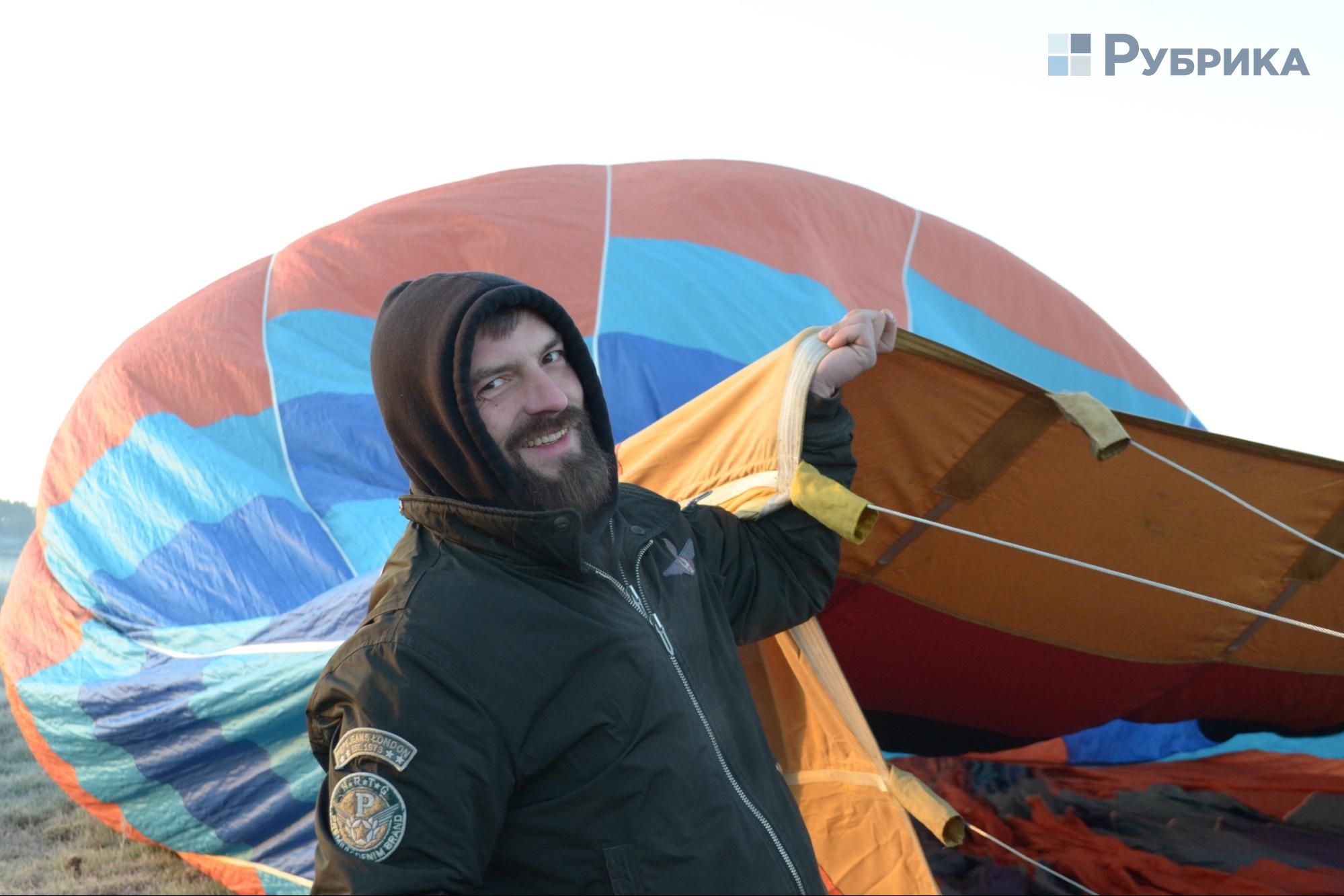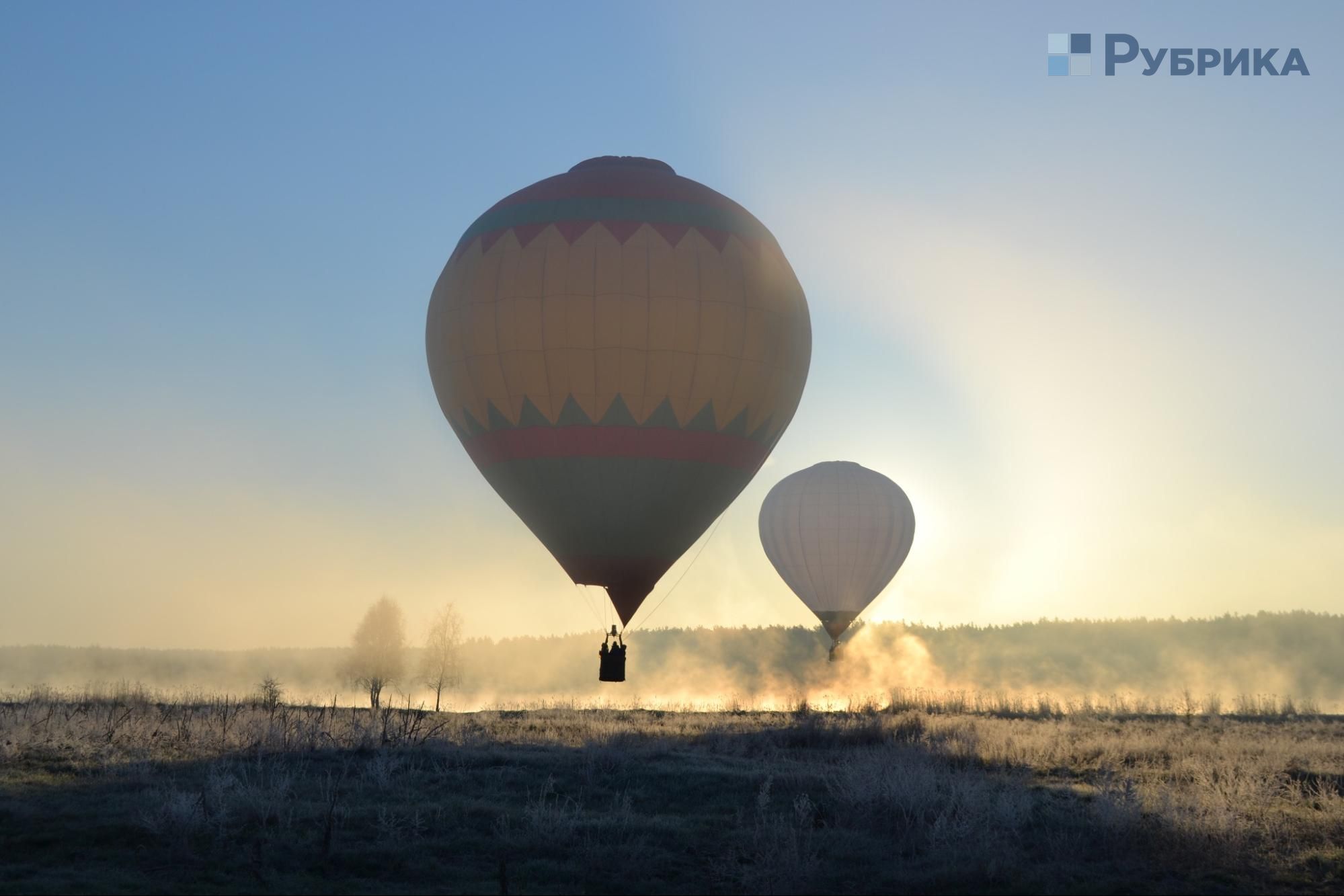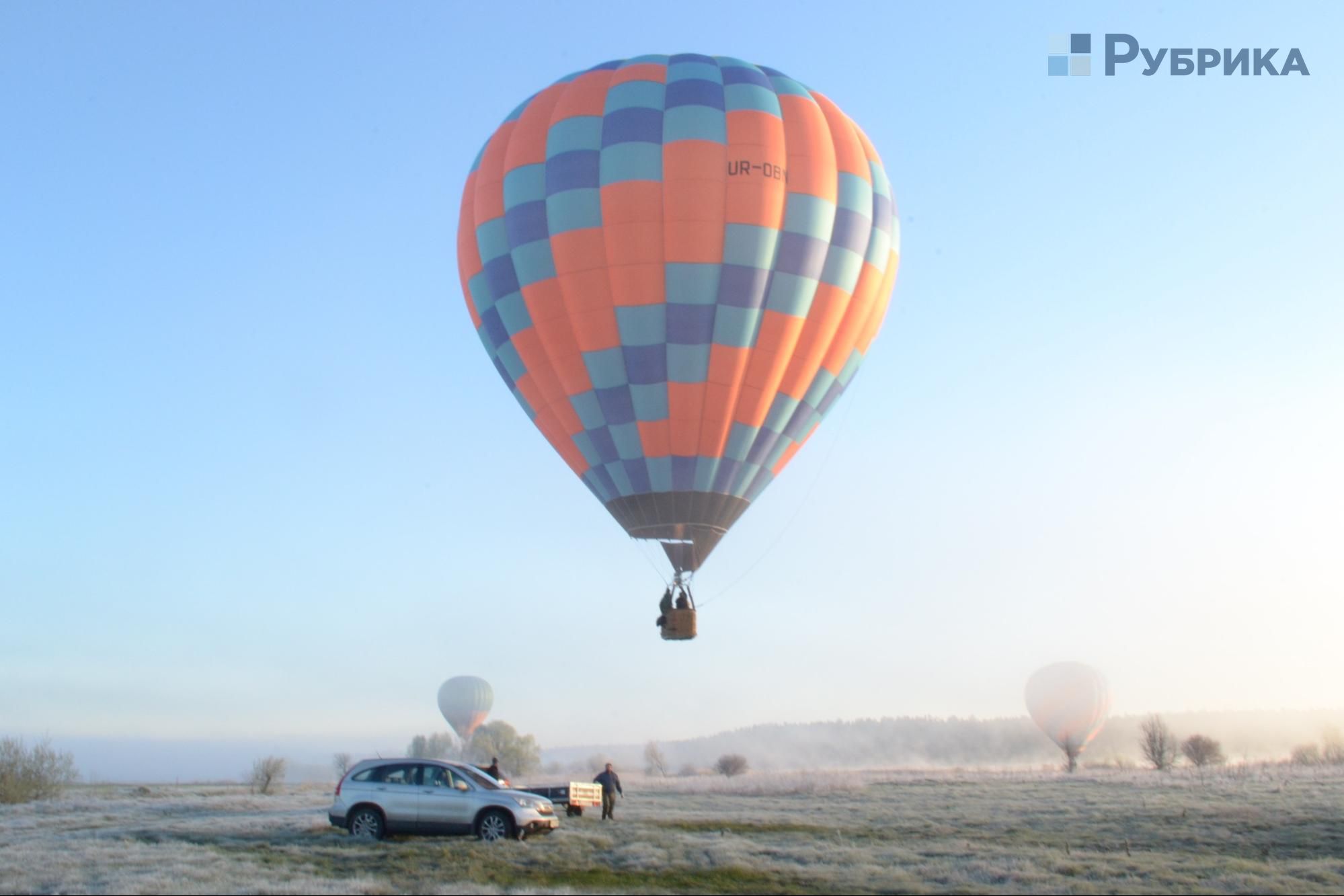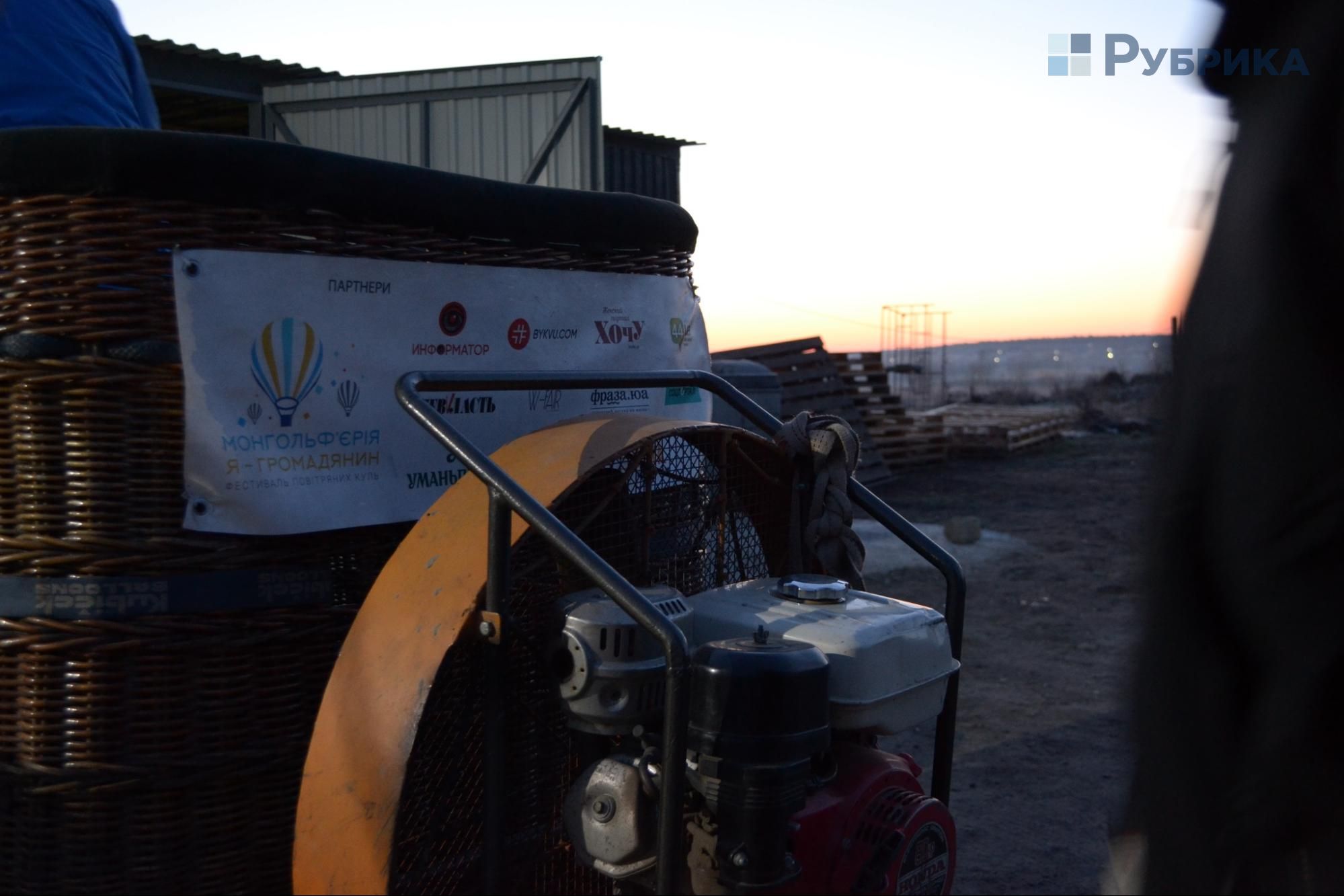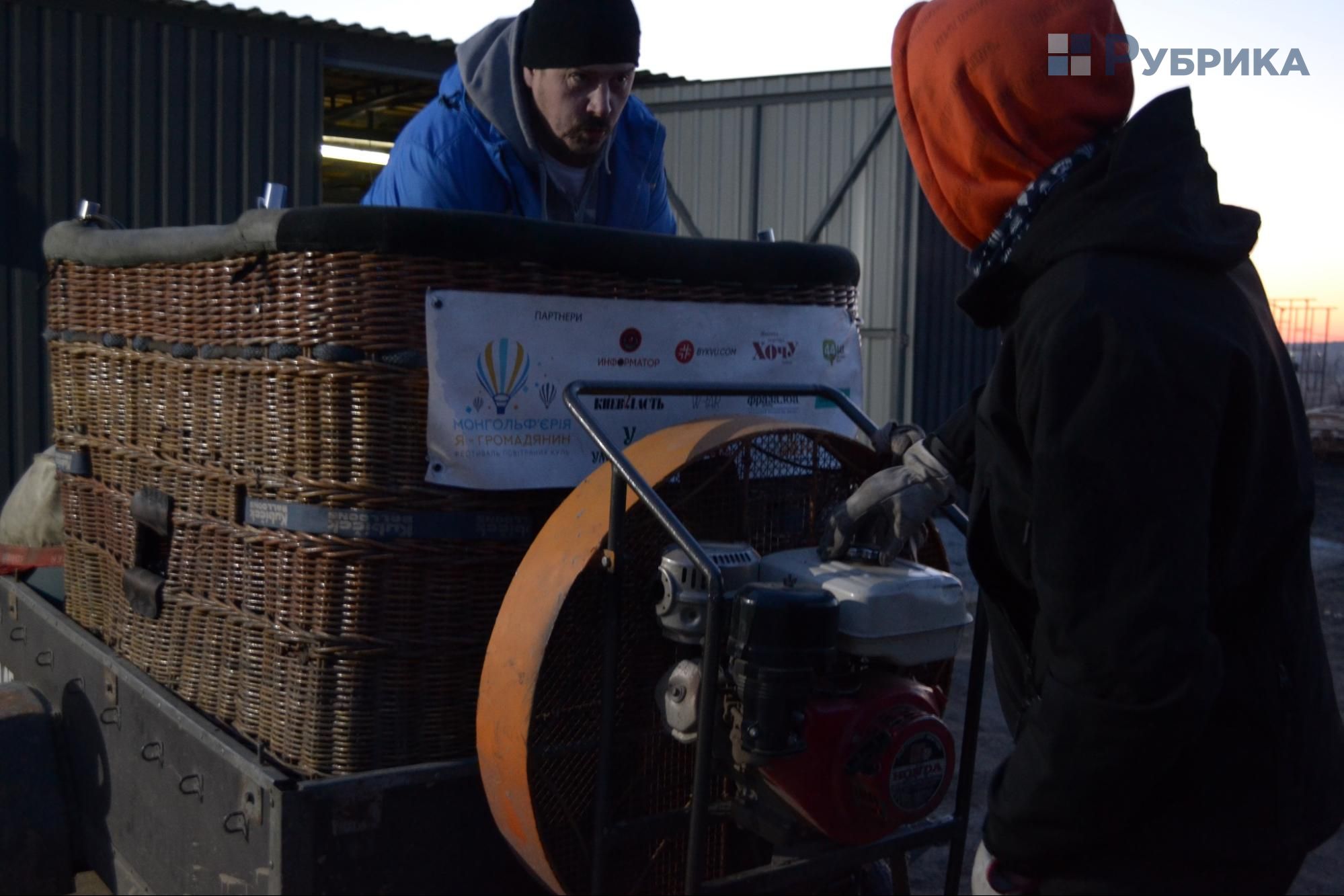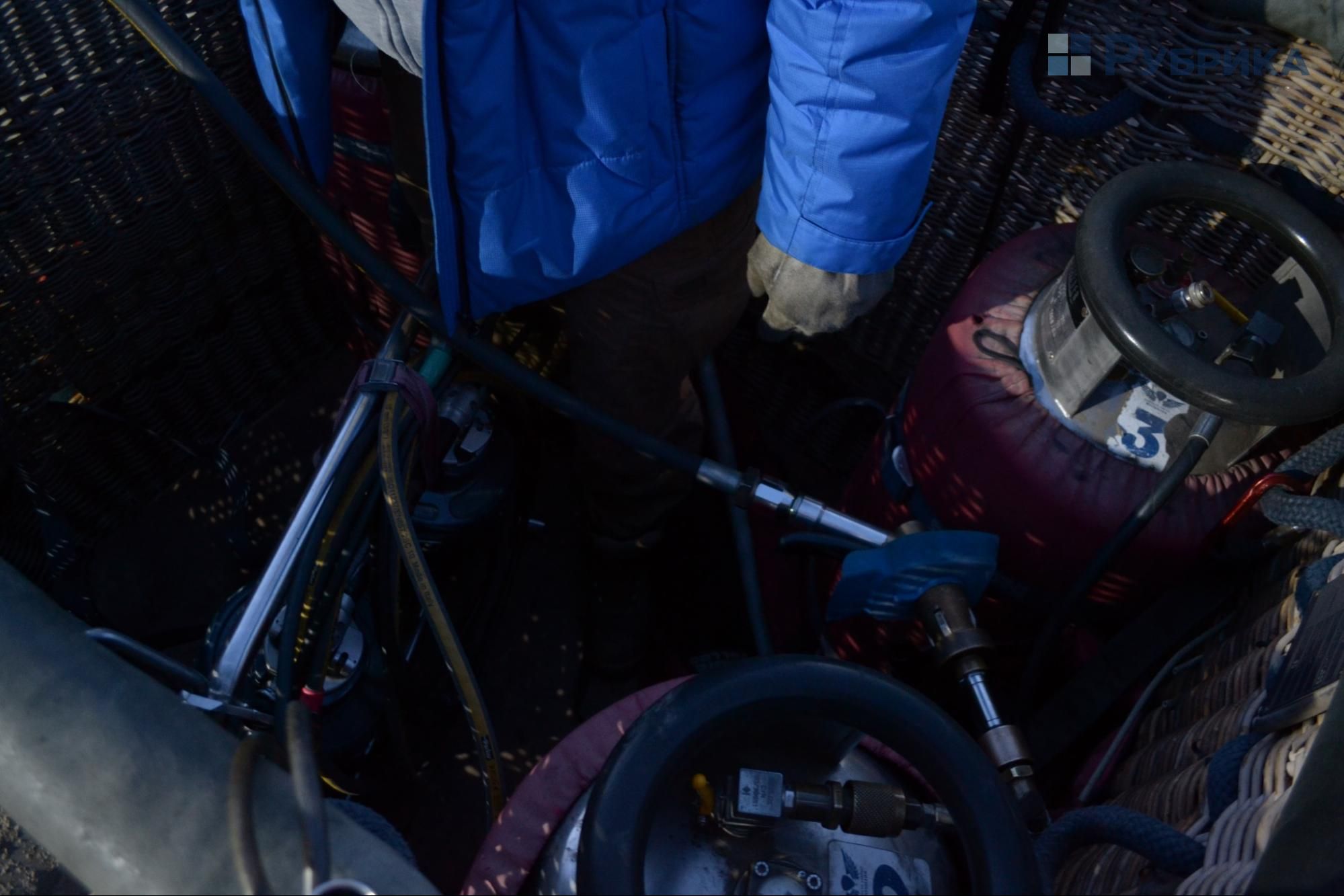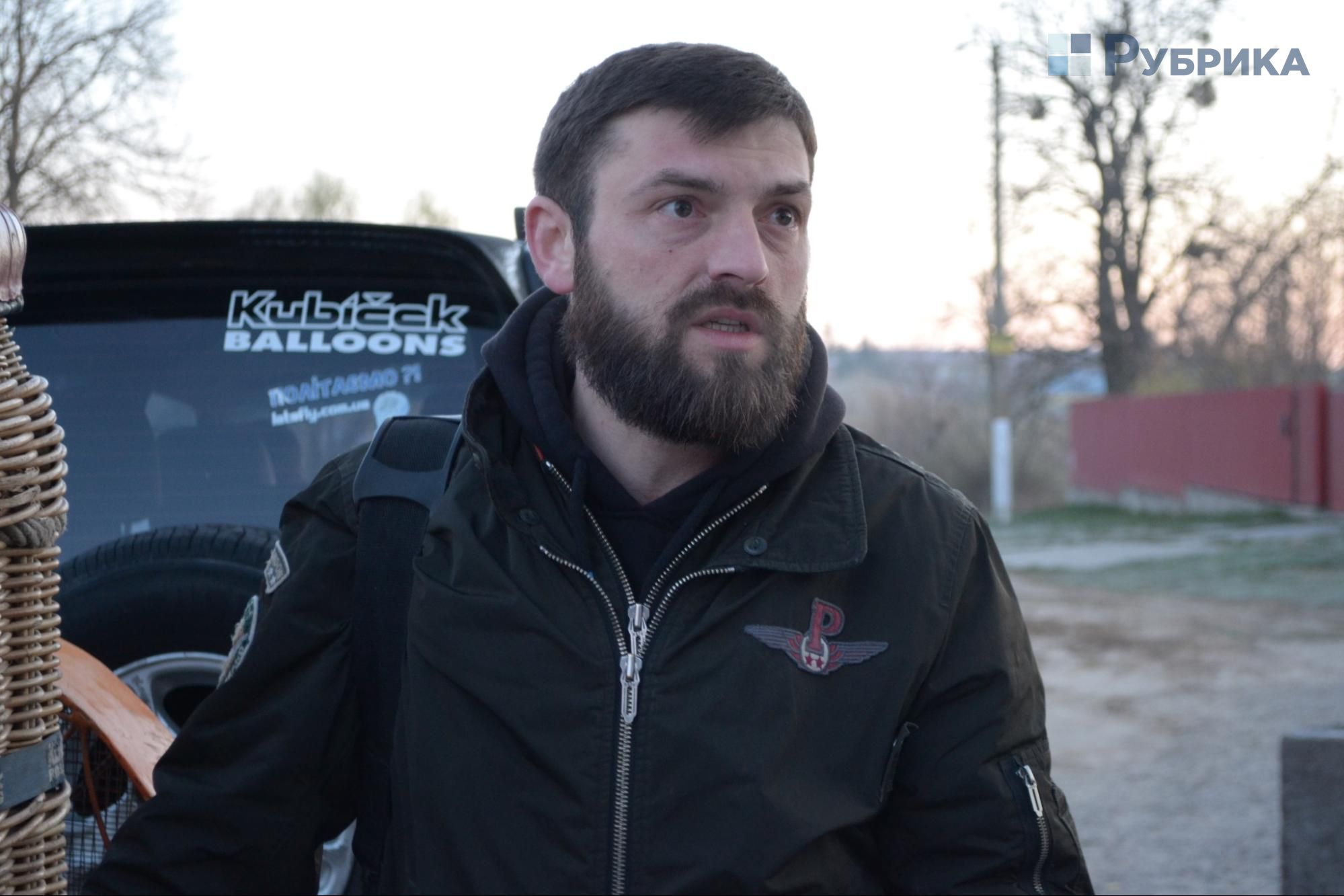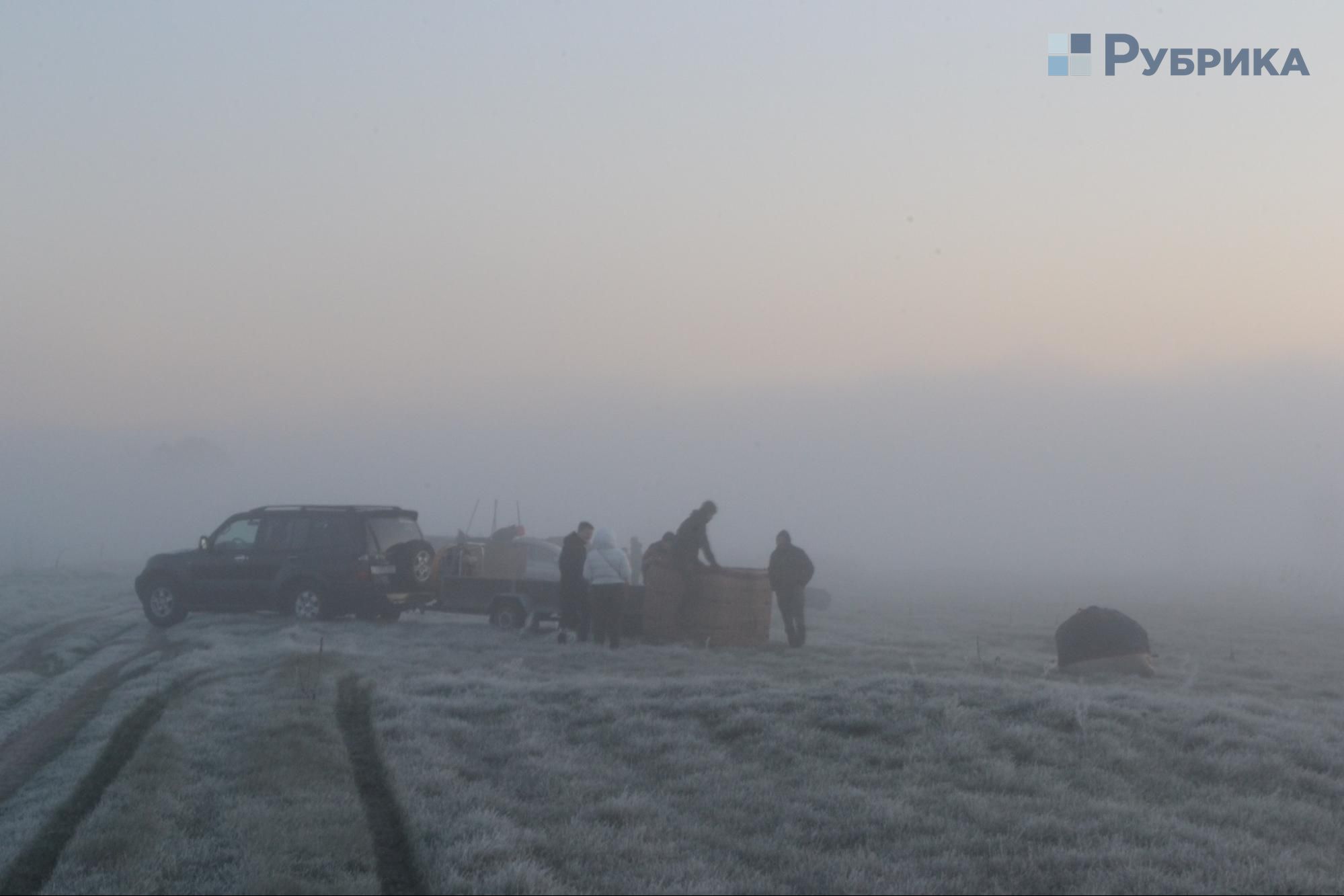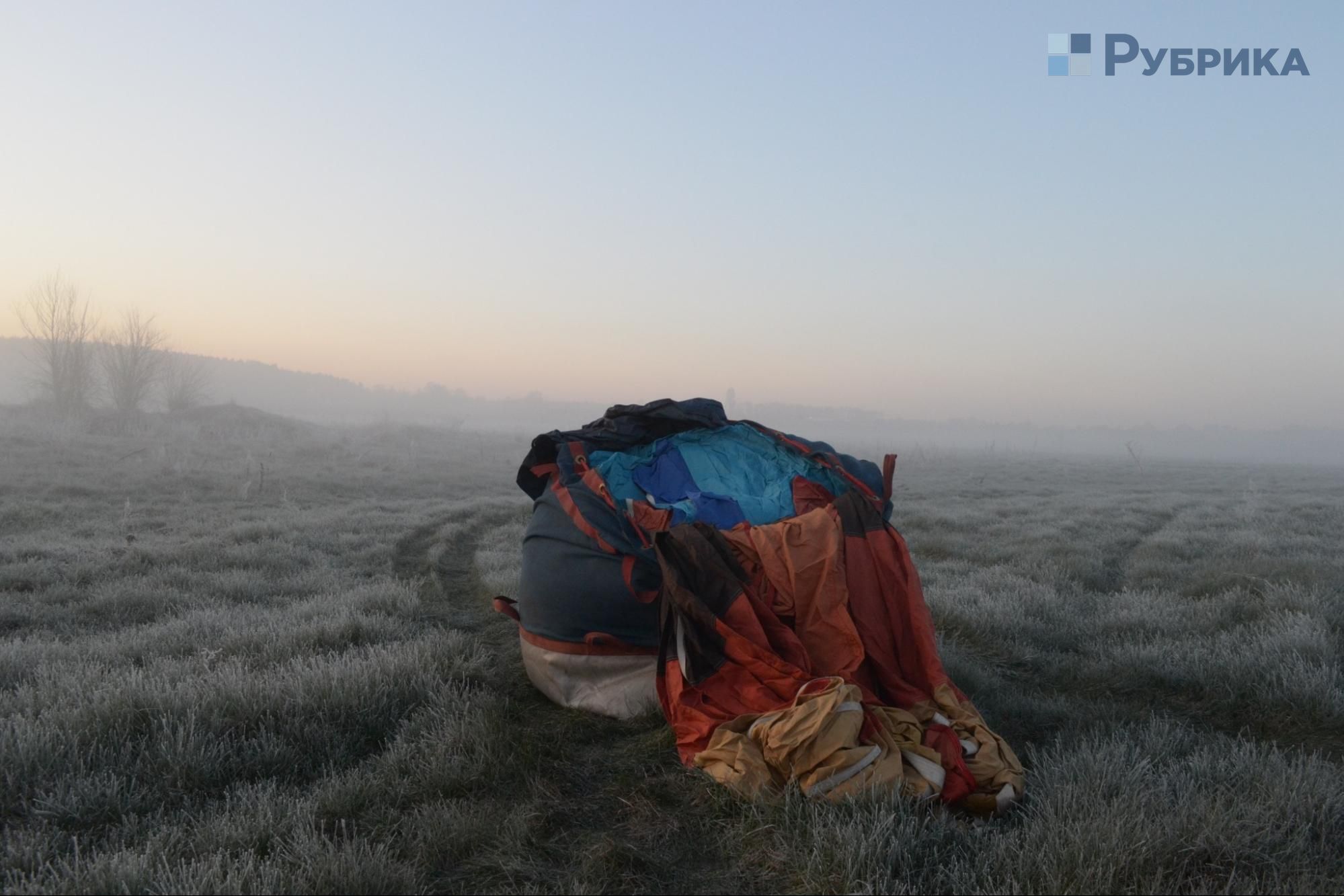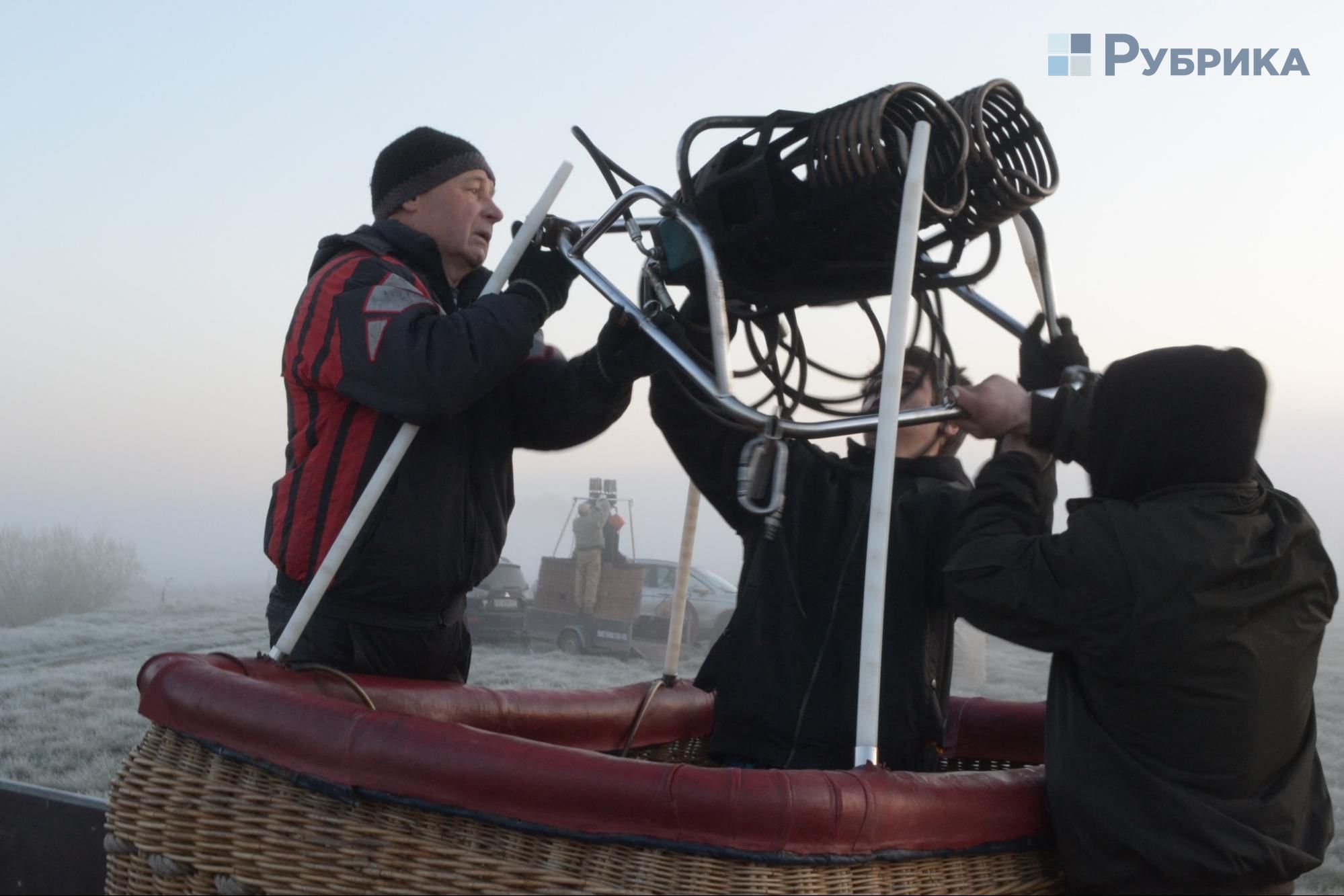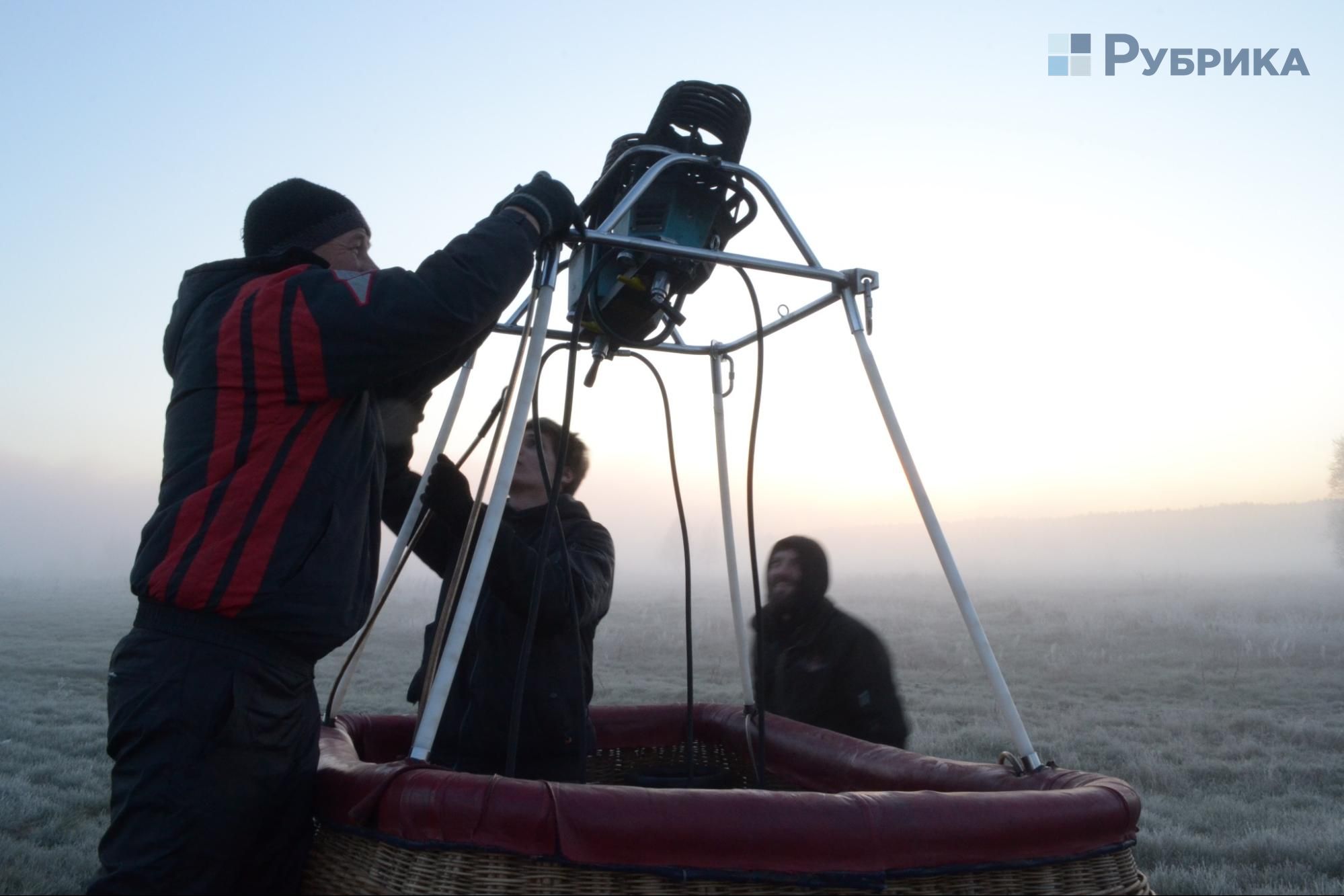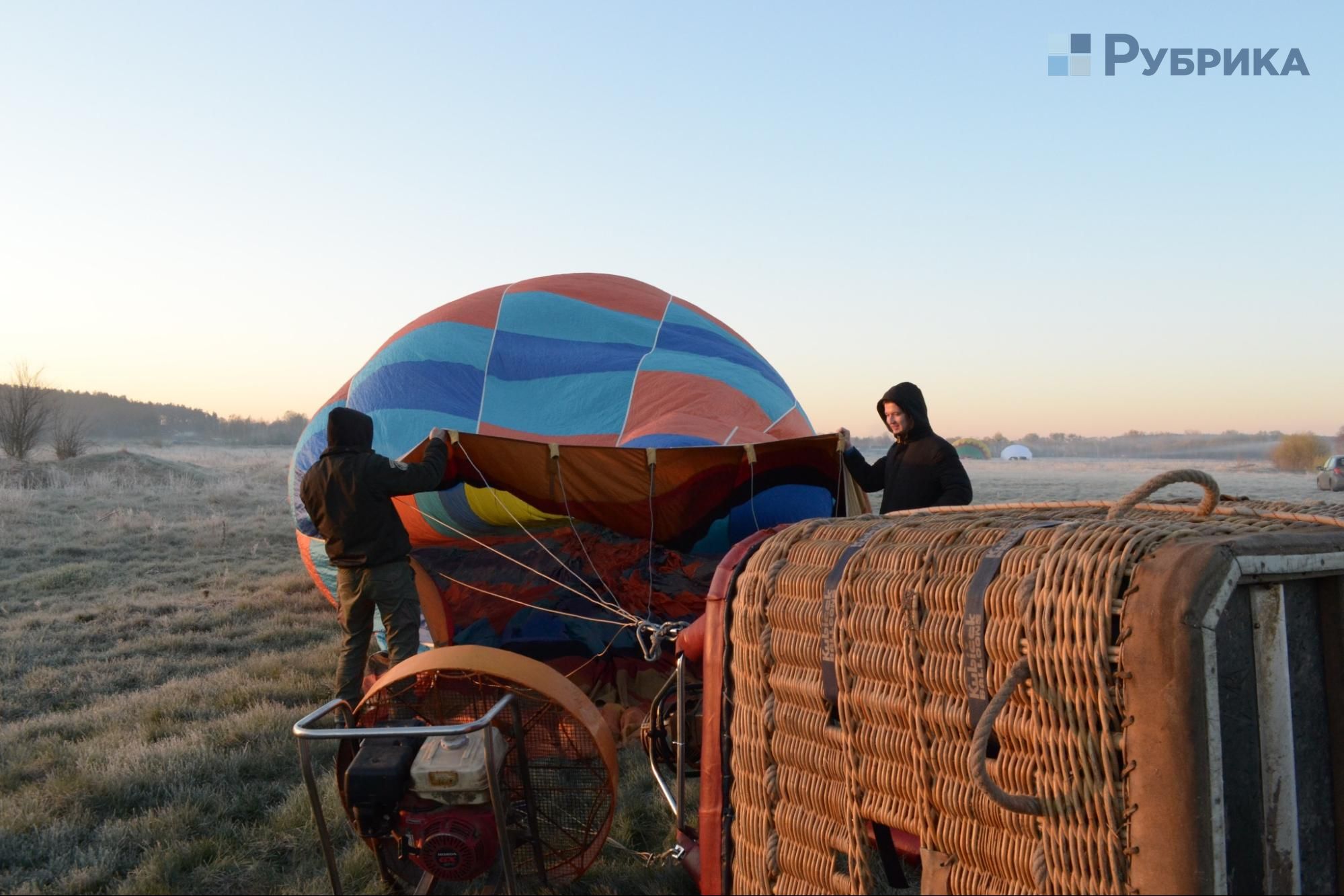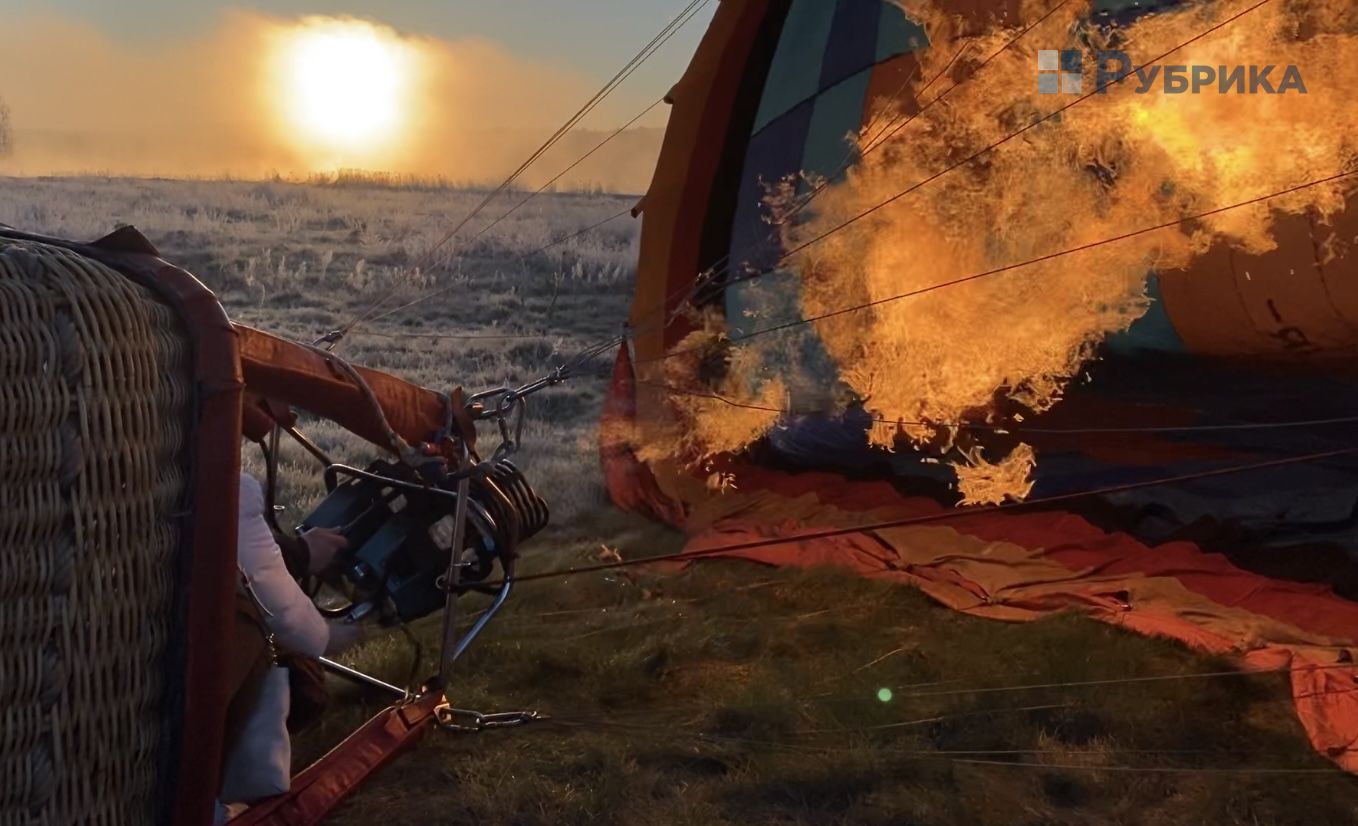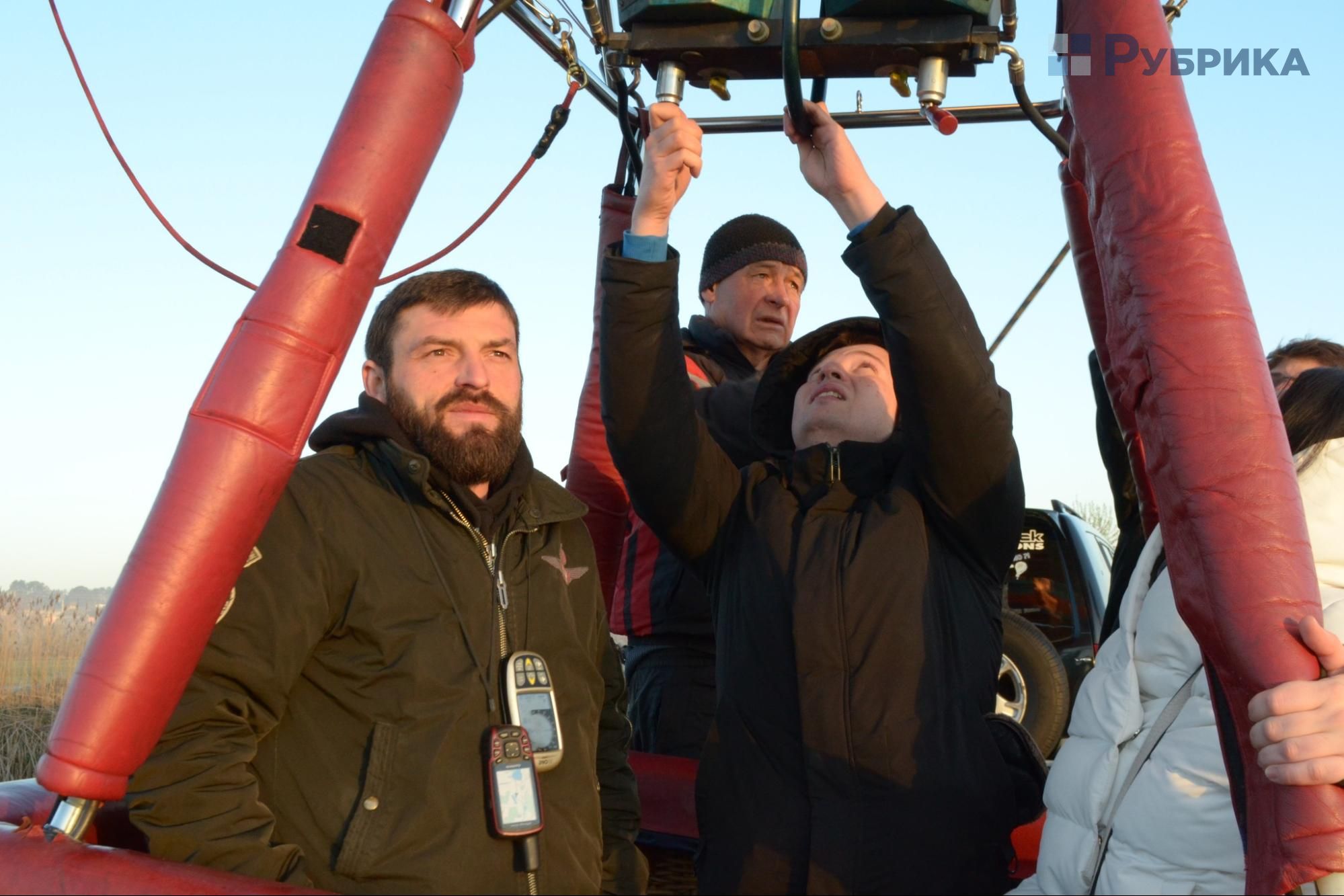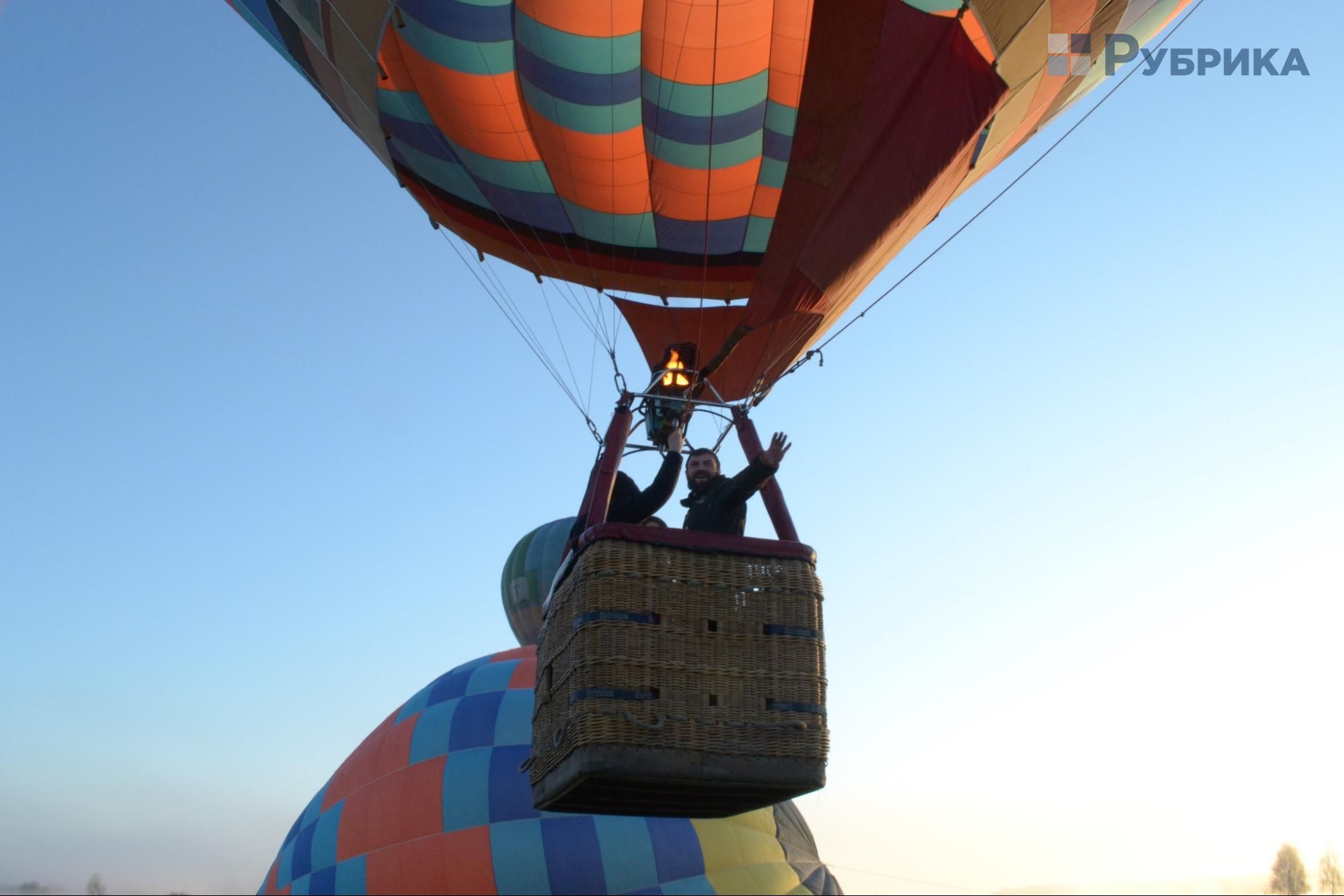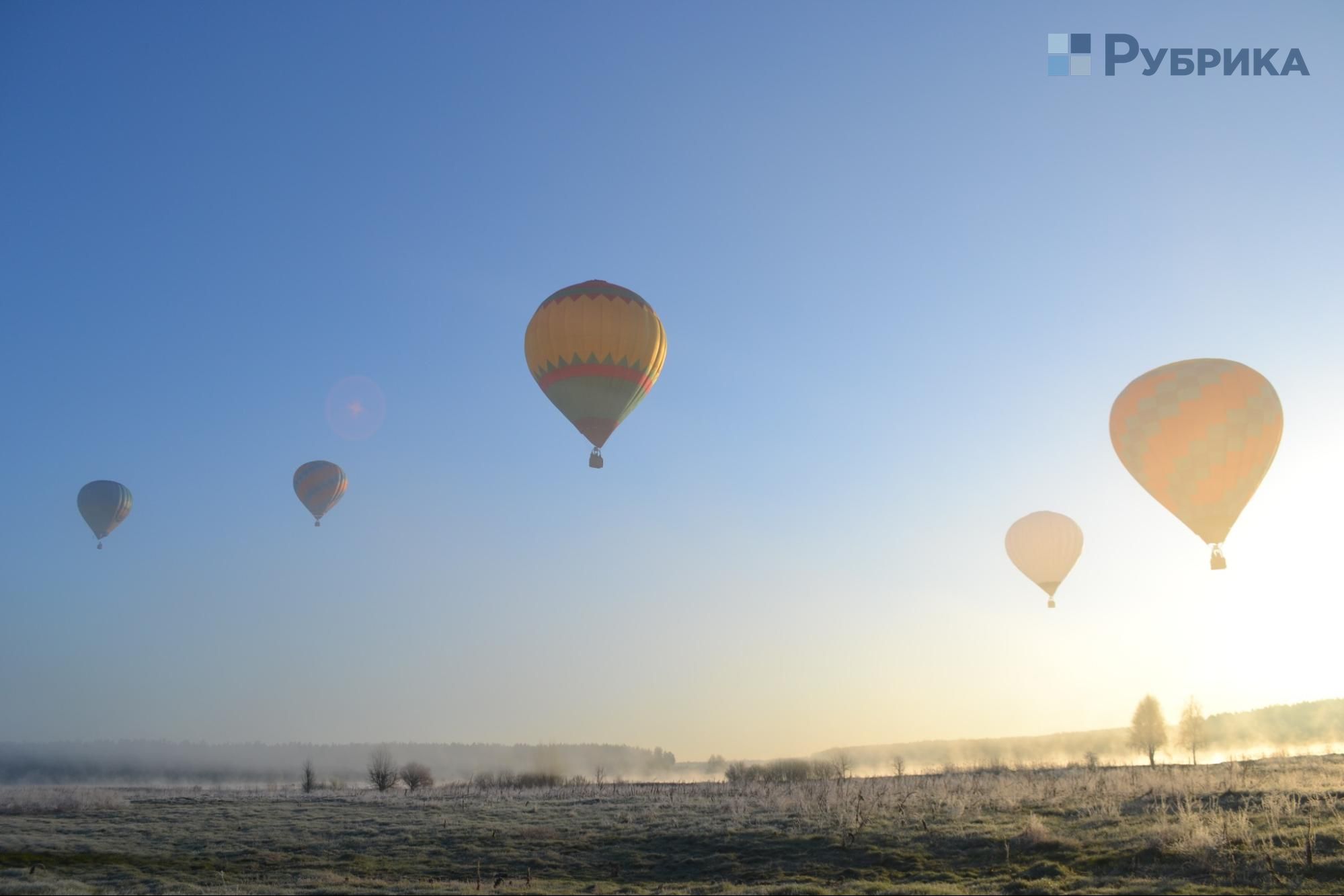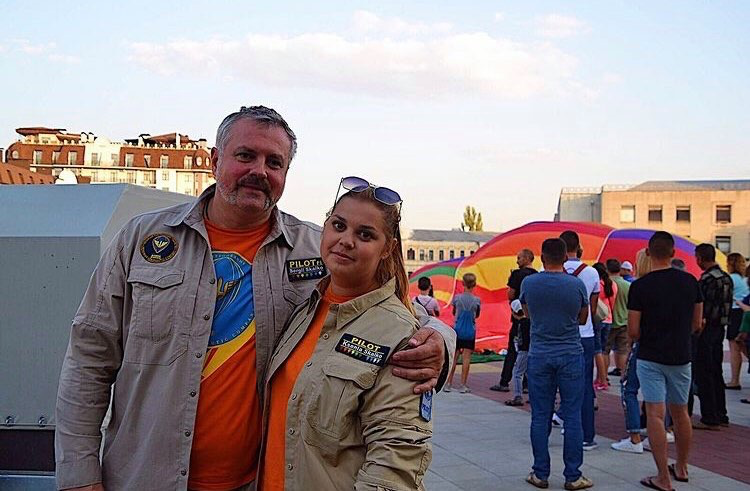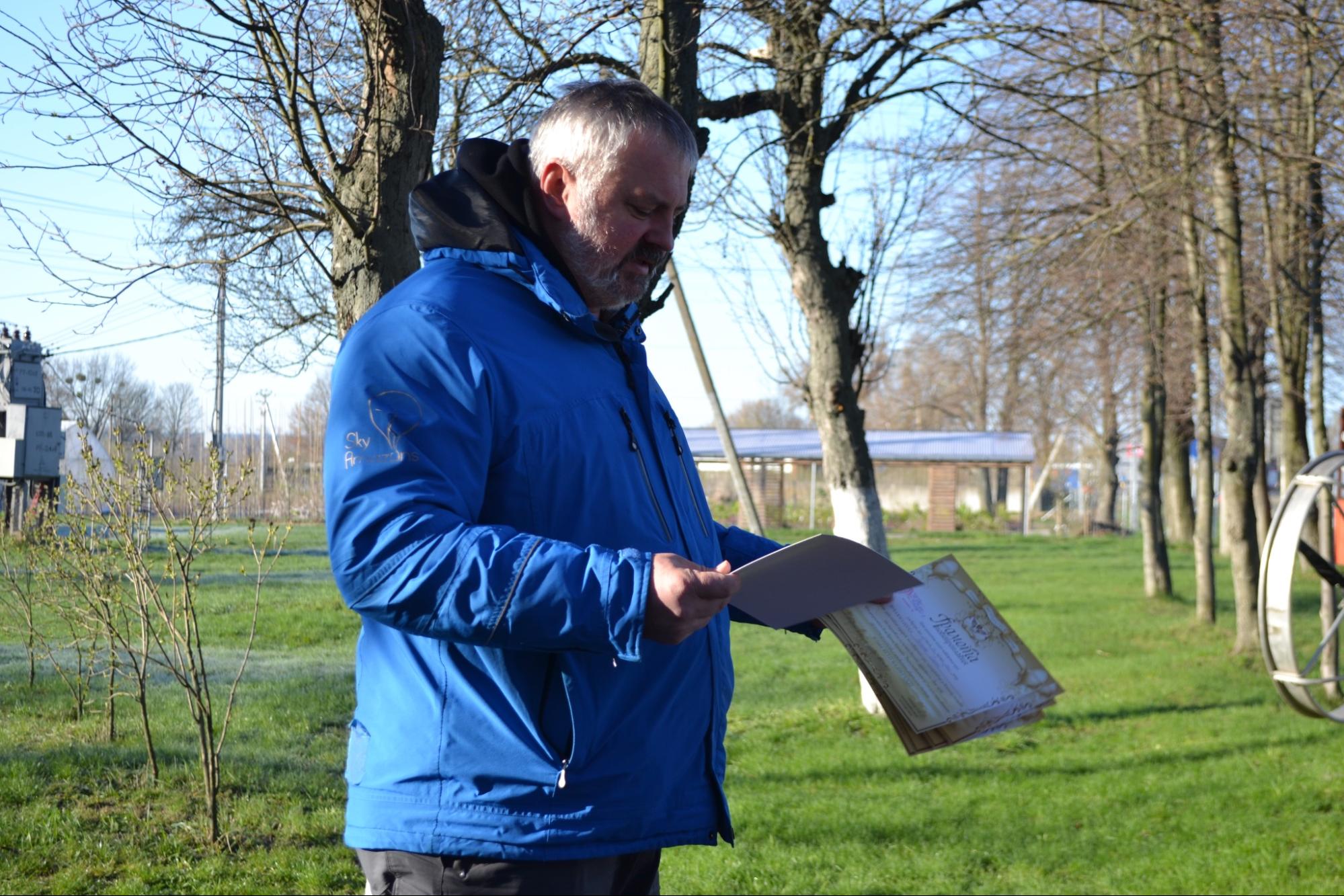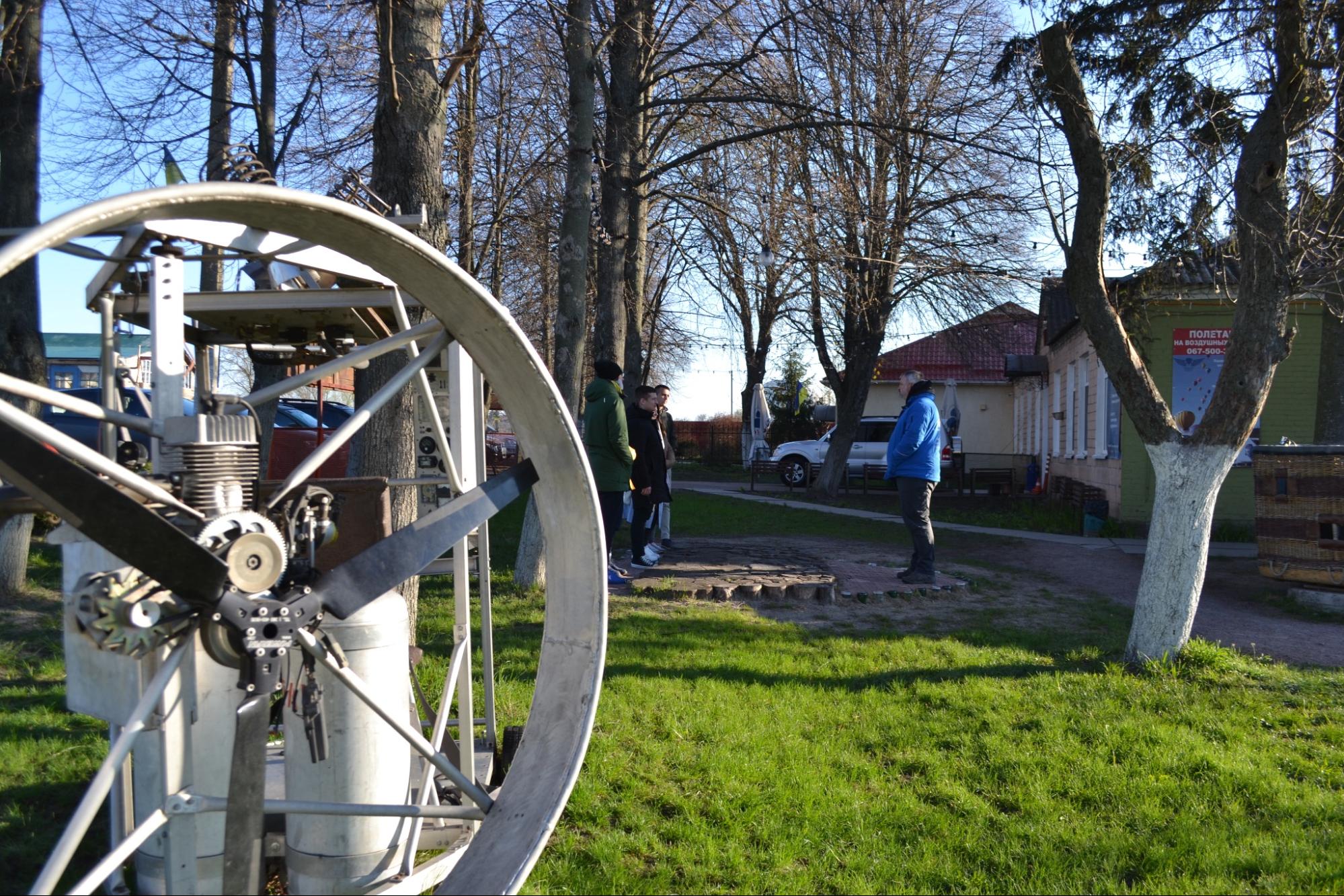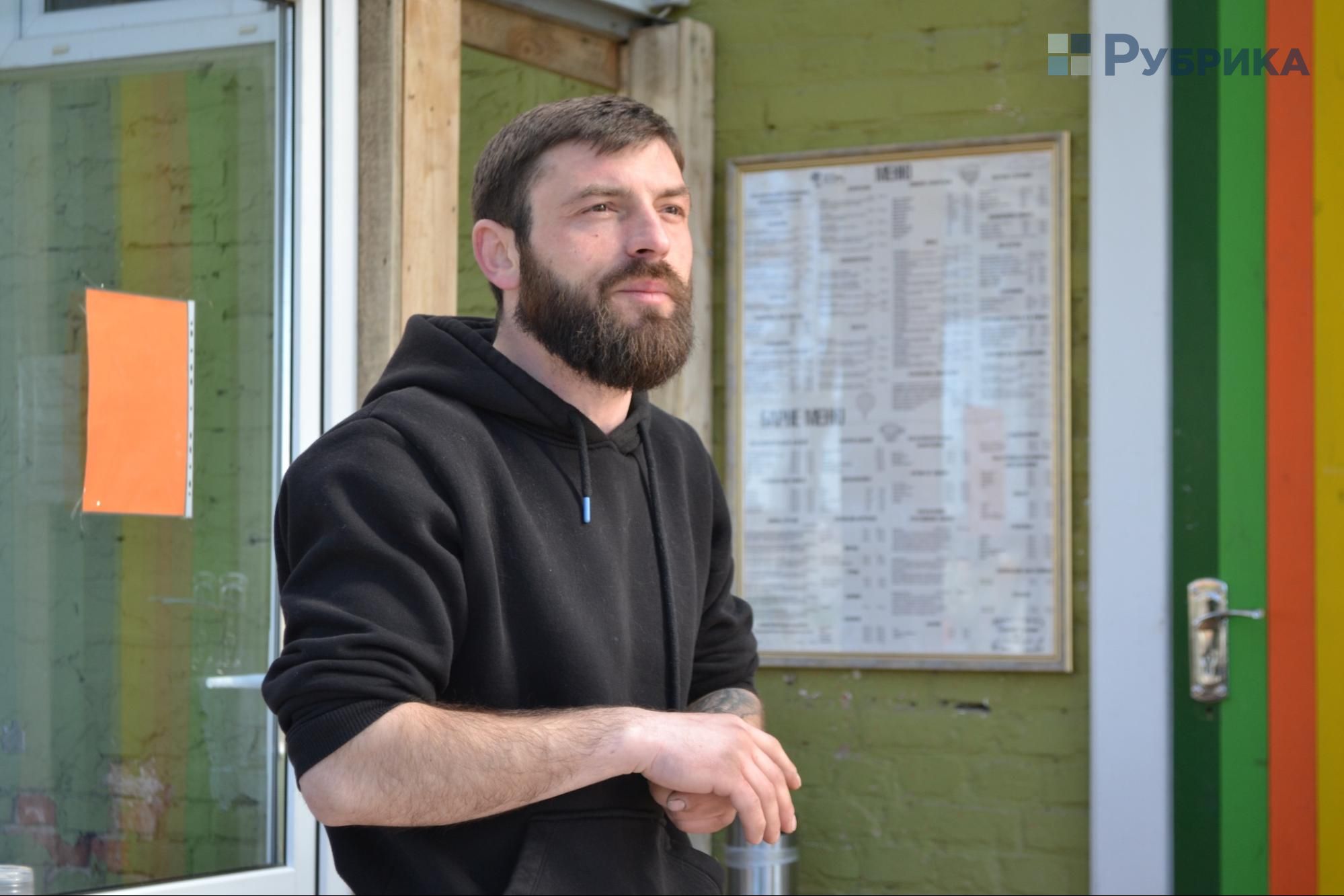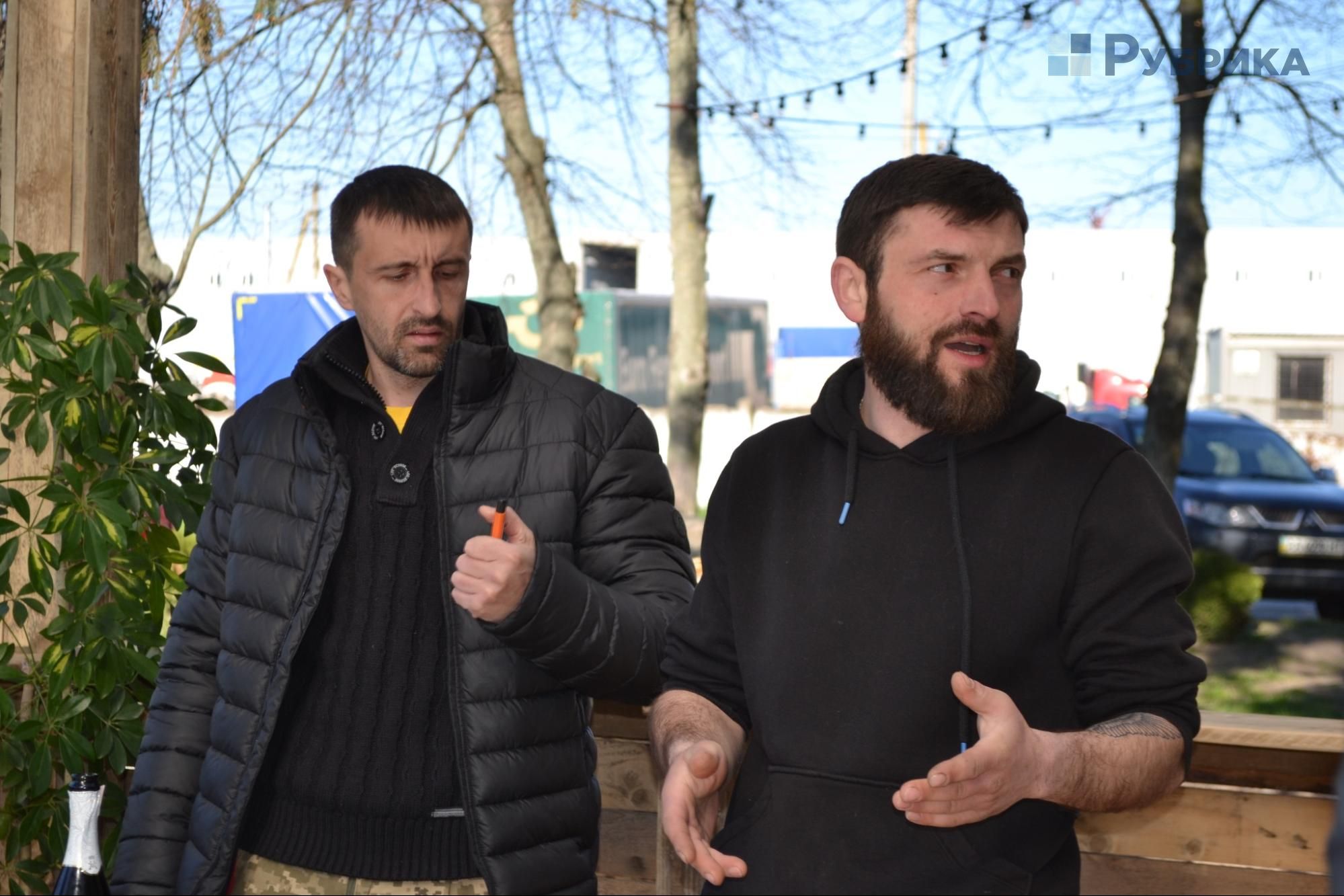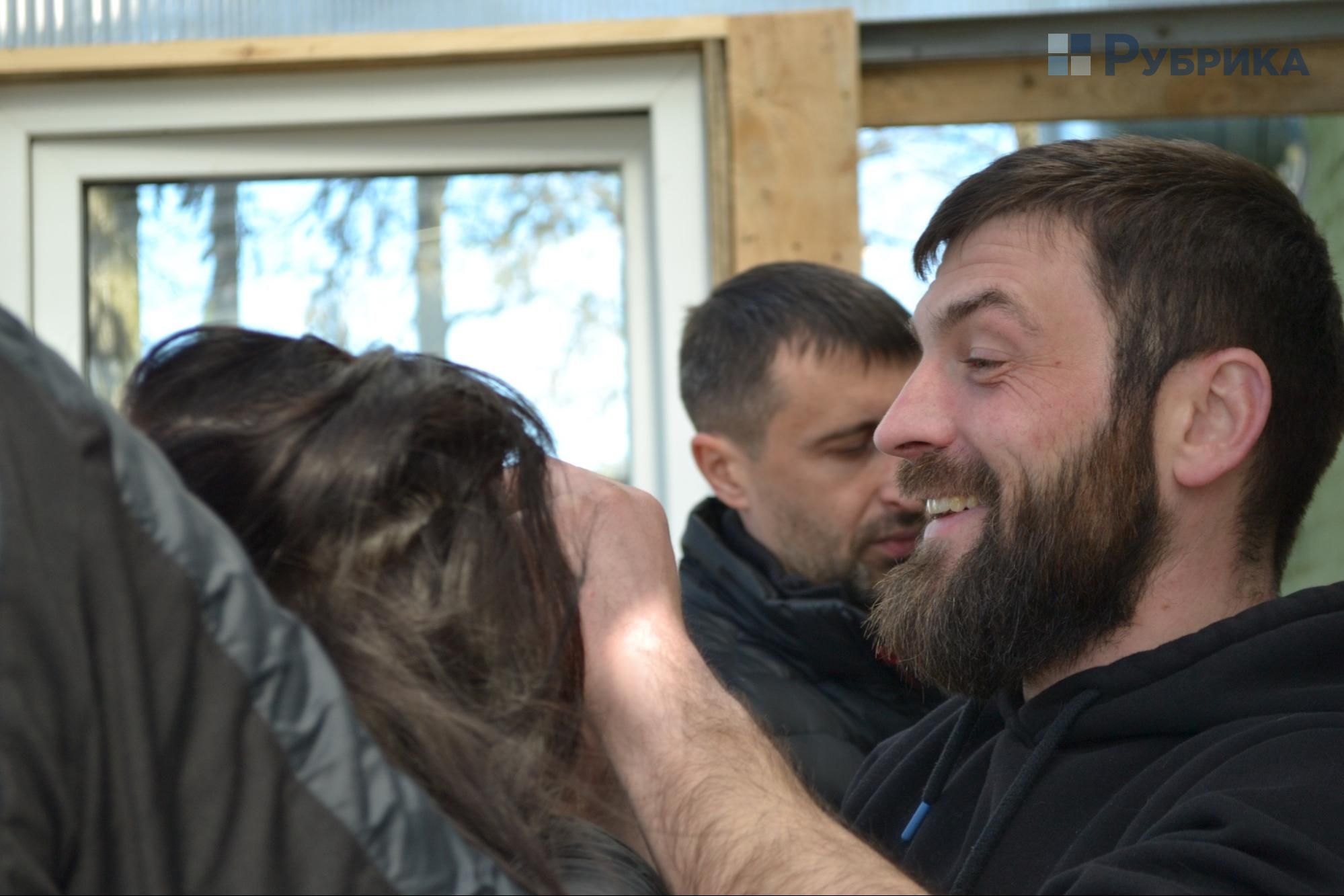You never know where you'll land: how Ukrainians fly in balloons
Rubryka saw the preparation for a balloon flight with our own eyes and has explained how this process looks from the inside. And also why everyone sitting in a wicker basket under a balloon should have the ends of their hair set on fire.
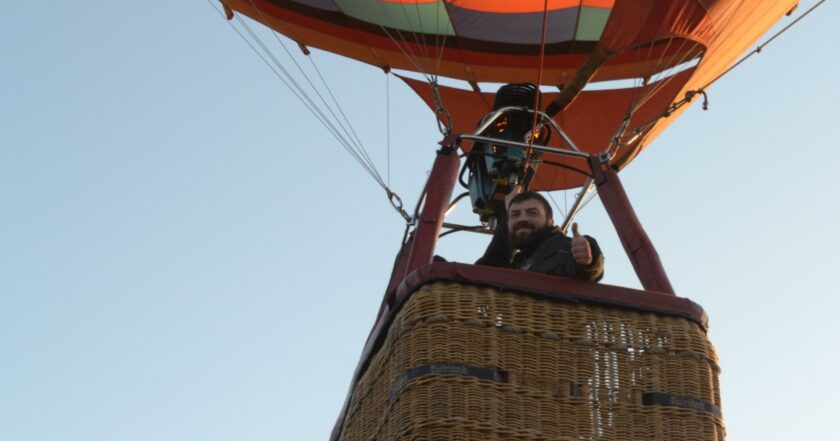
Once a journalist, marketer, and balloon pilot enter an aeronautical cafe. It sounds like an anecdote, but in fact, it's the beginning of the story about an unexpected acquaintance that resulted in this article.
I was having dinner with a friend in a suburban cafe, the interior of which spoke of involvement in balloons when a man with a thick beard entered the hall through the service entrance. The typical pilot stripes on the right sleeve and left lapel pocket struck the eye. The high spirits and a long pause in the conversation with my companion made me ask:
— Excuse me, are you a pilot?
— Yes.
— Like a balloon pilot?
— Well, yes.
Neither I nor the marketer who was with me, and stared at the visitor, didn't know about such a profession even existing. Our new friend's eyes sparkled:
— I'll tell you everything that interests you. The man was clearly disposed to talk, and we actively took advantage of this. Questions came pouring in. We asked them, vying with each other.
Our new acquaintance, Rostyslav Belinskyi, is a resident of Kyiv, the owner of a tuning studio, and a hot-air balloon pilot with a "flying time" approaching six hundred hours. Balloons are Rostyslav's genuine passion, which suddenly emerged in his life and even predetermined the place where he settled. We talked with Rostyslav about how it really is, managing an almost unmanageable type of transport, why pilots rarely know where they'll fly, and how to become a balloon pilot in Ukraine.
— Do I need to study to be a balloon pilot?
— Yes. Pilots are taught in our Kyiv Aeronautical Society. It costs about 3-3.5 thousand dollars, but the course duration is very approximate. The program is designed for 3 months, and who will study and how long depends on the cadet himself (Rostislav shrugs his shoulders)! Until you pass the theoretical and practical exams, you won't receive a license. I myself also teach lessons for novice pilots. I like it, but only as long as the person is into it. If I see a fire in their eyes, then my training is much more productive.
— How did you become a pilot?
— I fell in love with balloons. About seven years ago, my wife and I were choosing a place to build a country house. We went in different directions from Kyiv, toward the Odesa highway, and here, in the direction of Zhytomyrska. We came to look at the site near Makarov, a bare field, driven stakes, empty land. And then I heard thunder overhead in perfect weather! I look up and see a balloon flying over me! I immediately said that we were taking that site. On weekends I visited here and for the first two years, I just drove a car here to see balloons, and so I met the guys. Then I trained as a balloon pilot and have been flying for 5 years already. You can forget about sleeping! After all, you'll have to get up before the flight at 3 a.m.!
— Why do you need to wake up so early?
— Because we usually fly at dawn and before dusk, and before departure, we need to do a lot of preparatory work. We can do it at other times, but meeting the sun in a balloon basket is something magical. During the day you can take a nap for a few hours, and in the evening, flight again! The collection time at the base is different each time. Before the summer solstice, each next sunrise begins 3 minutes earlier than yesterday, and after June 21, on the contrary, 3 minutes later. In winter, you can fly only during the day.
— What's the most beautiful thing about flying?
— It's very cool when you rise above the clouds. We call this "breaking through the clouds." It can be cloudy below, but above, it's always sunny. I broke through the clouds and rose above them, it's insanely beautiful. The basket floats on them, but there's one detail; to go down, you need to wait until the ball cools down a little. The time I went up, there was a passenger with me, and at some point, she even began to worry. But we went down and everything ended well.
— Tell us how and where does the balloon get down?
— We never know where we'll land. I had an incident when I was still working with an escort, and a guy and a girl were supposed to fly. In the morning they weren't very enthusiastic, and that day it was also windy. The pilot warned them that the landing would be dynamic, as it directly depends on the wind speed, and said that they might not fly today. But they agreed. It's also important to say that the girl was in a white suit; I remembered that well. And so, after the flight, the balloon is going to land right on the field, which has recently burned out. Imagine how much soot there was! All black. I sit in the car and understand that's a disaster. The balloon rushes to land; we go after it, straight across the field. Dust rises behind the car, and the same thing happens behind the landing basket of the balloon. They slipped along the ground, probably 50 meters! I couldn't see the basket, only a black cloud of mud and ash.
We drive up to the basket and from afar I see the pilot and the guy with the girl are black like miners, only eyes and teeth are visible. The white suit, as you understand, also turned black. The girl is waving her arms, shouting something, and I thought she was angry, but no! There was such delight in her eyes: "This is exactly what we wanted!!!" So the landing can be different, but it is always soft because the basket is woven from a vine. It absorbs well, and if you bend your knees and hold on to the handles inside the basket, everything will go smoothly.
It seemed that Rostyslav was ready to talk about balloons endlessly, and we listened to him with pleasure. The waitress hinted several times that the cafe would close soon; we had to leave, but I already knew for sure that this meeting wasn't the last. Not sharing this story with readers is a crime against all balloon pilots in the world, and, fortunately, our hero agreed to be interviewed. And not just for a half-hour conversation. As a journalist, I was lucky enough to go backstage on the entire team involved in flights and even get acquainted with the Ukrainian record holder and founder of the Kyiv Aeronautical Society and the Montgolfieria balloon festival, Serhii Skalko.
Flight preparation: what things you can't take off without
I meet with the team in the same aeronautical cafe at 5:10 am; the time is set exactly because in the early morning everything is calculated up to a minute, you can't be late. Minute by minute I drive up to the meeting place, see Rostyslav and almost immediately start asking questions because time is running out.
— What we must do before the flight?
— It's imperative to compare all the weather forecasts that we align with from the Internet and aviation weather stations. It's imperative to double-check all the equipment whether it's filled, and when everything is complete, a balloon and gas cylinders. We launch a balloon inflated with helium into the air. We look to see if the forecast matches the current one or not, and we look at the thunderstorms on the radars, whether the winds are getting stronger, whether there are thunderstorm fronts above us, — Rostyslav talks about all the preparations quickly, because the passengers have already gathered at the base, who need to be organized and told about the safety rules. Although the clock is only 5 am, work is already in full swing.
For an outside observer, flight preparation is divided into two stages; this is how I divided it for myself. The first is what happens at the base. The gas cylinders, from which the burner will be ignited for heating the air in the ball, are filled with propane-butane. The type of balloons that rise from the heated air is called hot air balloons. Flights on it are relatively cheap, so it's used more often, but there are also Charlière gas balloons filled with helium:
— These are flights on gas balloons. Trucks arrive with a bunch of helium cylinders to fill the balloons. Such flights cost up to 15 thousand dollars.
The filled cylinders are put into the basket, and the basket is loaded onto the trailer. The trailer is attached to the car, which will accompany the balloon. Meanwhile, the passengers get to know their pilot, undergo instructions, and mentally prepare for the flight, and the team that completes everything they need launches the very helium balloon that Rostyslav spoke about into the air.
While I was watching the basket being loaded, one of the guys, also a pilot, Sasha blew a red balloon, and his team, Roman and Viktor, began to accompany me after him: "You'll skip all the fun." Sasha crosses the road, carrying a helium balloon in his hand, and I think: "Perhaps now I'll see a spectacular moment," but as soon as I blink, the balloon has already risen several meters above the ground. "Is that all?" I ask. "Well, yes, that's all," the pilot replies.
To be honest, launching the balloon was promising, but didn't live up to expectations. However, this stage cannot be underestimated, because, by the speed and where the red ball flies, the pilots determine from what point the big balloons will have a start. Sasha immediately calls someone and says: "Let's go to the old bridge."
— The take-off point is different each time. Sometimes we take off from here, and sometimes we need to go 30 kilometers, – the pilot explains.
It takes about an hour to pack the equipment. Then everyone gets into their cars and goes to the take-off point. Today is the first day with summer weather after a long break between flights, so we're moving to the take-off point in a whole motorcade; today 6 balloons will set sail across the sky.
How to fly a balloon?
From the moment you arrive on the field, all the fun begins. In the early morning, everything is covered with frost, the fog hasn't cleared yet and everything looks like in a movie.
A basket and a parachute are unloaded from the trailer, and an incredible cloth is packed in a relatively small bag.
Then the basket is assembled; the slings and burner are attached, a special cable is installed, connected to the valve in the balloon cover. This is a very important detail and the only control tool for the balloon. If you pull the control halyard, the canopy rises and hot air comes out of the balloon, and the descent begins.
— Where are you going to fly today?
— I don't know! I have no idea! — Rostyslav laughs. The thing is that a balloon is an almost uncontrollable form of transport. It flies with the speed of the wind and in its direction, and it's impossible to change the flight trajectory. By the way, the fact that the balloon moves simultaneously with the air currents gives an interesting effect: passengers don't feel the wind. —We rarely know where it will fly, and where approximately the landing point will be. We can say during the flight. We can only roughly tell the direction towards the wind. We're usually followed by an escort, several cars. Their task isn't to lose us and meet us at the landing point, return the balloonists to the base.
— How long can a balloon fly?
— Temperature, cylinders, wind speed are the factors the flight range depends on. For example, in winter, you can fly for a very long time. Now it is 0 degrees outside, and the air temperature in the balloon's shell should be 76-80 degrees, and if it is -10 or -15 outside, then 40-50 degrees will be enough for lift, and the power reserve will be 4-5 hours.
When the basket is assembled, it's turned over on its side and the parachute is deployed. Its dimensions are enormous, 28 meters high, like a 9-story building. The propeller, which was installed on the trailer, is removed and turned on; its only function is to force air into the ball.
— How far can you fly in a balloon? (Now I have to shout over the noise of the propeller).
— My longest flight is 60 kilometers, but in general, there's an all-Ukrainian record; a person managed to conquer 708 kilometers in a little more than 12 hours, in a 36-seat basket. It was done by Serhii Skalko. Typically, the range depends on the wind speed and the amount of gas. Our flight will last about an hour, but how many kilometers we fly depends on the wind's speed.
Then the most extreme part begins. Rostyslav climbs into the basket, which is still on its side, turns on the gas burner, and a flame bursts out of it. I was immediately overwhelmed with warmth, although I was standing a few meters from the fire. The burners continue to force the warm air into the dome; it is due to it that the balloon with the basket rises into the air.
After a couple of minutes, the basket begins to rise, standing in the correct vertical position, and Rostyslav deftly jumps between the lines, resembling a cabin boy on a sailing ship. When the balloon is in an almost vertical position, there's no time to waste, because it's almost impossible to contain the enormous lifting force. At this point, all passengers should take their seats.
After a long, multi-stage preparation, the flight looks almost sudden. Rostyslav looks at the horizon, and the basket has already lifted off the ground. We were just standing next to it, and now the pilot and his two passengers are already several meters taller than me.
The pilot looks down from the basket and smiles; he wasn't so happy, even when he talked about flights when we first met. I understand that every time is like the first one for him. After takeoff, I, one more photographer, Andrii, and the cars, which now have to follow the balls, remain on the field. Andrii and I are returning to the base, where we'll wait for the team of balloonists.
One big family and initiation into aeronautics
The waiting time passed in a conversation with a girl with big hazel eyes. This is Ksenia, the club administrator, and at the same time, the young balloon pilot:
— It was my father's dream to make me a pilot. We at Don Ballon are one big family. Serhii founded the society 15 years ago and connected all of us to this business. My mother used to cook in our cafe, Dima, my brother, runs the cafe, I am a pilot, Dima's wife deals with finances, and dad manages all of us.
Ksenia's father is the same Serhii Skalko, who has set more than one record in aeronautics in Ukraine, including for the longest flight. It becomes clear where all these numerous awards in the office and cafe come from.
— Competitions are often held in Germany and Austria. I went to them a couple of years ago, those are my business trips, — Ksenia laughs.
The fact that the balloonist team are active competition participants is evidenced by numerous awards in the Don Ballon office and cafe. Small bags of sand hang on the wall, markers, are an obligatory attribute of aeronautics competitions. The pilot must drop the marker on the target marked on the ground. At the same time, you cannot throw with an "overlap" but only vertically. The winner will be the one with the most accurate hit. While I was studying the markers, Rostyslav returned with the passengers.
It's time for initiation. Those who fly on a balloon for the first time are never told all the details of this ritual, and at first, everything looks pretty ordinary. Rostyslav tells the story of the invention of the balloon by the Montgolfier brothers, about the first flying machines, the first flight of the Marquis de Santa, and his amazing decree: everyone who stepped on an aircraft receives a title of nobility and feudal land, the ownership of which is valid only if the owner is above 1 meter above the ground. After that, the most amazing thing happens:
— We must pay tribute to four elements, — Rostyslav declaims, — the earth for a soft landing, water, lakes, and rivers that can be observed from a balloon, the fire that heated the air in the balloon's shell, and most importantly, the wind that carried our balloon across the sky. Therefore, now we'll set fire to a piece of you, it will fall to the ground, we'll quench it with champagne, and the ashes will scatter on the ground. Seeing a lighter in the pilot's hands, young aeronauts begin to worry, but Rostyslav assures: This is done all over the world!
He takes a lock of hair from a nearby girl and sets it on fire. They used the same procedure to all the other people. Men with very short haircuts also cannot avoid going through the ritual; they set the hair on their hands on fire. Everyone laughs, champagne opens, and certificates are issued to the newly minted nobles.
Blitz
— Have you had extreme flights?
— All dangerous flights are associated with wind speed. And they were all controlled because we do not fly under really dangerous conditions. If there's a potential risk, don't fly.
— Do you have your own balloon?
— No, but of course I would like to have it. A good balloon with a basket and equipment costs about 45 thousand dollars. So far, I have other priorities, but in the future, of course, I'd like to.
— Will you teach your kids to fly?
— If a kid wants, I'll definitely teach her. My daughter is 8 years old, and she wants to fly with her classmate. I don't know when it will happen.
— Can you fly over Kyiv?
— Yes, but you can only start from the Hydropark, and fly in only one direction, from 35 degrees to 70. It turns out such a narrow corridor is everything that our airspace allows us.
— How much does a pilot earn?
— It depends on the weather. It happens that it's not the right week, and sometimes it's two. Therefore, besides the work of the pilot, there must be some other basic one, — Rostyslav advises. He has a sports car studio; he's in love with this business as much as he is with balloons.
— Does a balloon pilot have to undergo a medical examination?
— Pilots must undergo an aviation medical examination at Boryspil airport. This is a mandatory rule, and if you don't have yourself examined, you may not fly. Good physical condition is a must. We are tested from start to finish, and then, they issue a certificate. You cannot fly without it.
— Can a balloon rupture in flight? Does it leak water?
— No. It's made of very dense material. The fabric is like the umbrella fabric, only much stronger. The fibers adhere so tightly to each other that it doesn't allow air or water to pass through.


